The ASUS Zenbook UX305 Review
by Brett Howse on March 25, 2015 8:00 AM ESTGPU Performance
On the GPU side, the Core M-5Y10 has the Intel HD 5300 Gen8 graphics of Broadwell, but with clock speeds of 100 Mhz to 800 Mhz, as compared to the 5Y71 which has 300MHz to 900 MHz available. We have tested several Broadwell processors so far, and the Gen8 graphics are a reasonable boost over the Haswell Gen 7.5 model, with a bump in execution units (EU) from 20 on Haswell to 24 on Broadwell. The Yoga 3 Pro has the Core M 5Y71, which on paper should offer more performance than the 5Y10 based UX305 that we received for review.
One thing that became clear on the Yoga 3 Pro review was how even though the GPU was the same number of EUs as the Broadwell-U processors, and it has the same base and boost clock speed, the 4.5 watt window of Core M limited performance quite a bit. As we saw on the system performance already though, ASUS has elected to allow Core M to get hotter, so that may change the outcome on the GPU as well.
FutureMark 3DMark

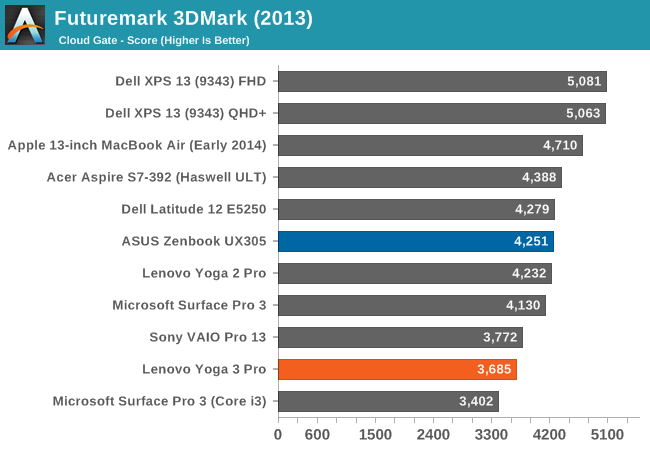
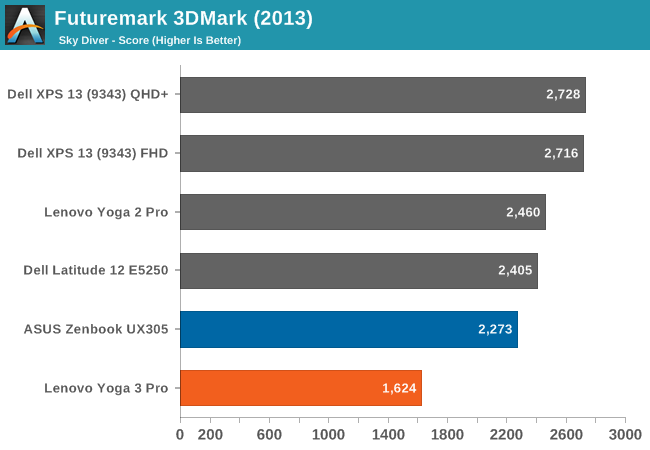

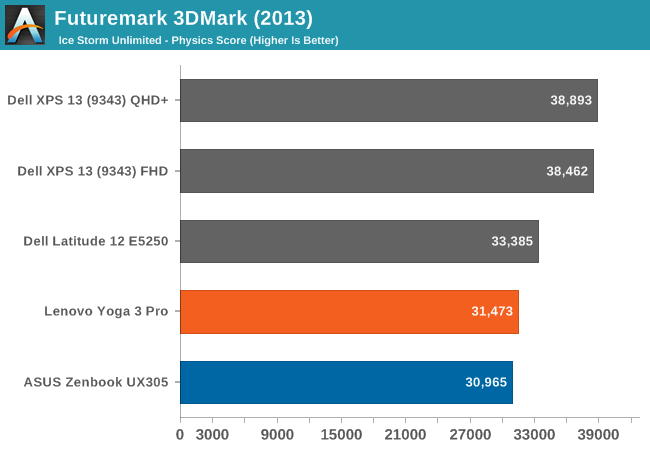
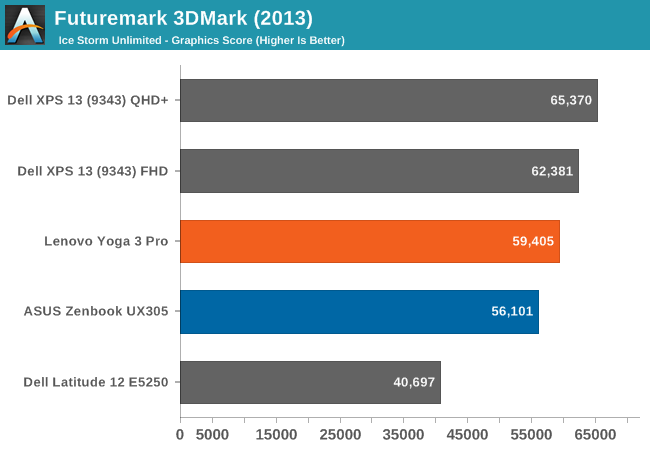
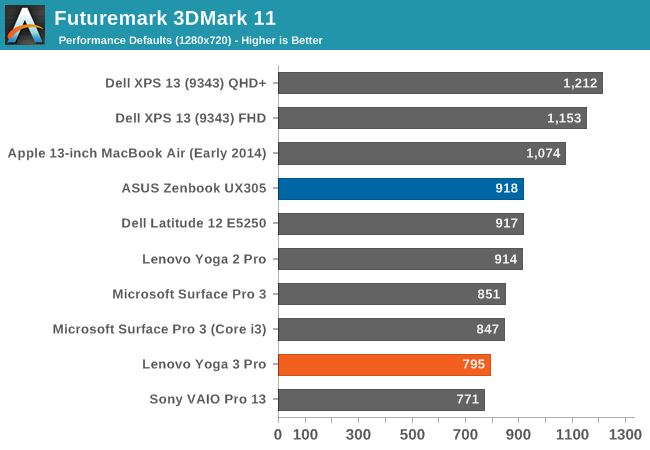
FutureMark has compiled several benchmarks in 3DMark 2013. All are a reasonable length, except for Ice Storm Unlimited which is more of a smartphone/tablet benchmark, and therefore completes very quickly on a PC. Here we can see how much more performance the ASUS UX305 can deliver over the Yoga 3 Pro, which again on paper has a faster processor. ASUS allows much more thermal headroom on the SoC, which results in considerably better scores when using the GPU. The exception to this is the Ice Storm Unlimited, which completes quick enough that the Yoga 3 Pro does not have to throttle as much.
GFXBench
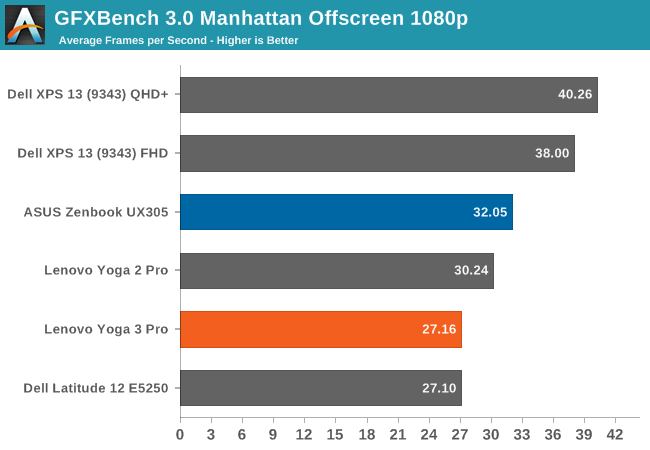
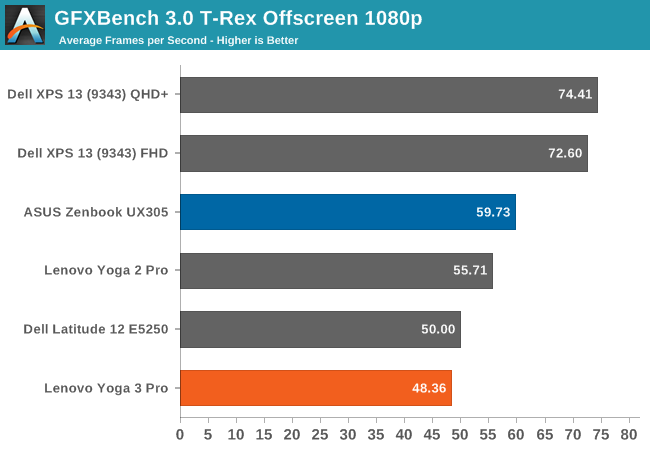
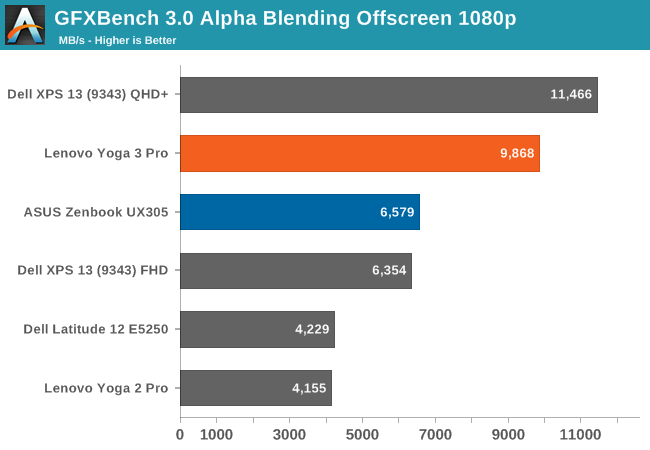
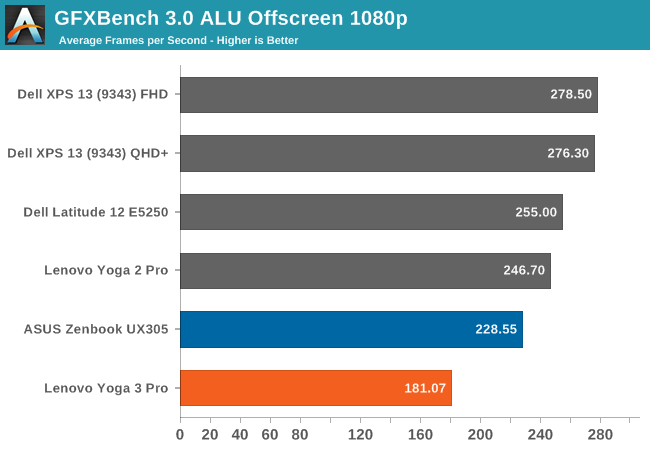
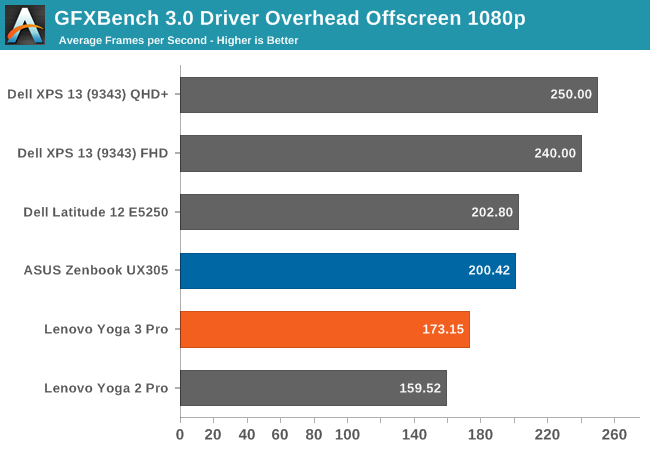
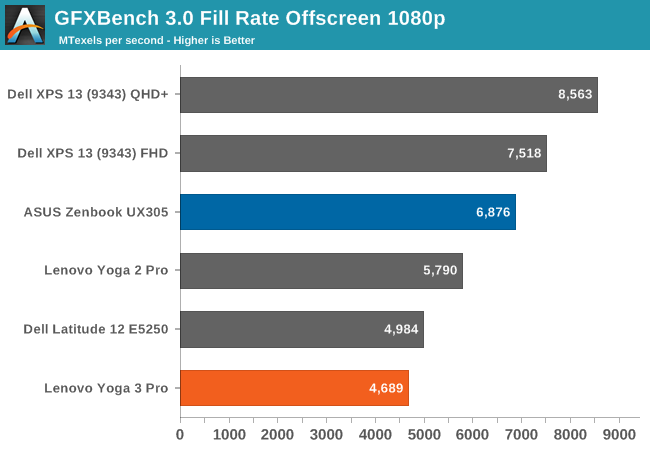
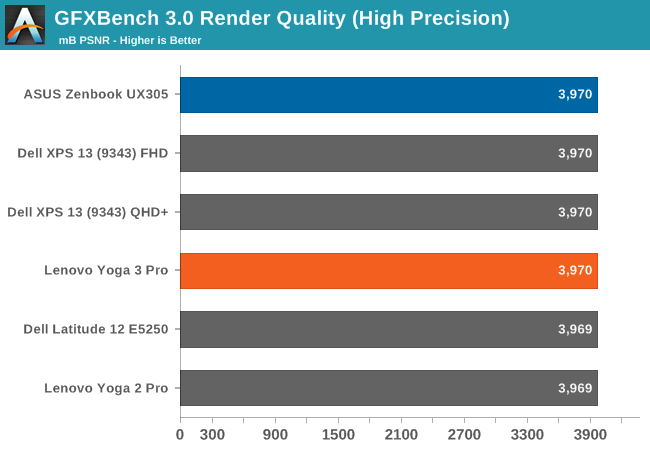
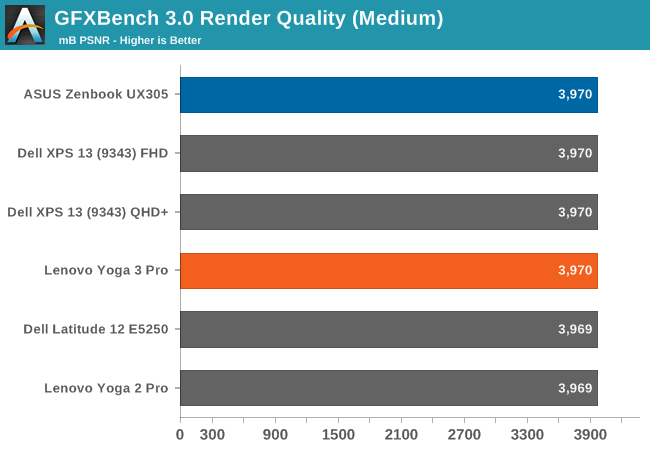
GFXBench 3.0 is available in the Windows Store, and is a DirectX version of GFXBench. On the two gaming benchmarks (Manhattan and T-Rex) we can see that the UX305 pulls ahead of both of the Haswell-U based devices in our graphs, which are the Yoga 2 Pro and the Latitude 12. The Dell XPS 13, with Broadwell-U, is still a lot more powerful which is not surprising since it has a 15 watt TDP compared to just 4.5 watts on Core M (Broadwell-Y). Once again, we can see that the ASUS is stronger than the Yoga 3 Pro.
DOTA 2 Benchmarks
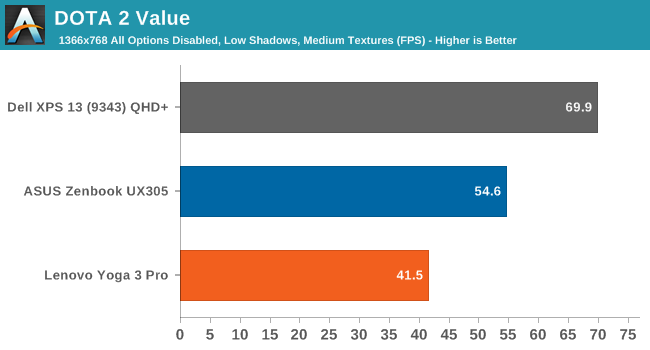
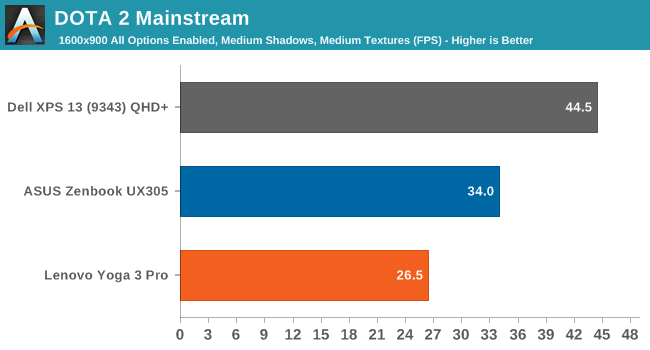
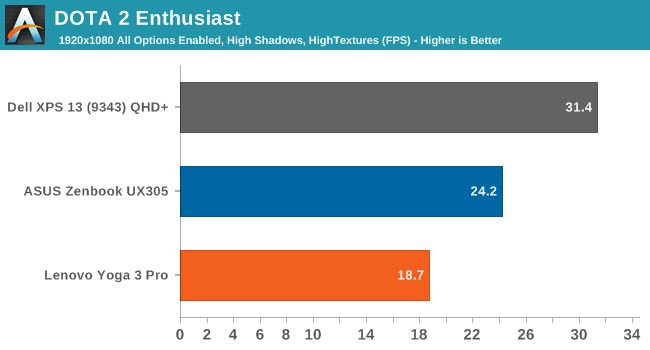
One area where the Yoga 3 Pro struggled was with our DOTA 2 benchmark, which is quite long in duration. We run at three different levels, and the Yoga 3 Pro fell quite far behind the Dell XPS 13. The ASUS UX305 closes that gap though, and gave a much higher frames per second than the Yoga 3 Pro.
Tablet Comparison
As with the Yoga 3 Pro, we will compare the ASUS UX305 to several tablets to see where Core M fits in the lineup. The UX305 is certainly not a tablet competitor unlike the Yoga 3 Pro, but the improved GPU performance seen in the laptop comparisons should give us some more information to about where the Intel graphics compare to the best SoC GPUs available today.
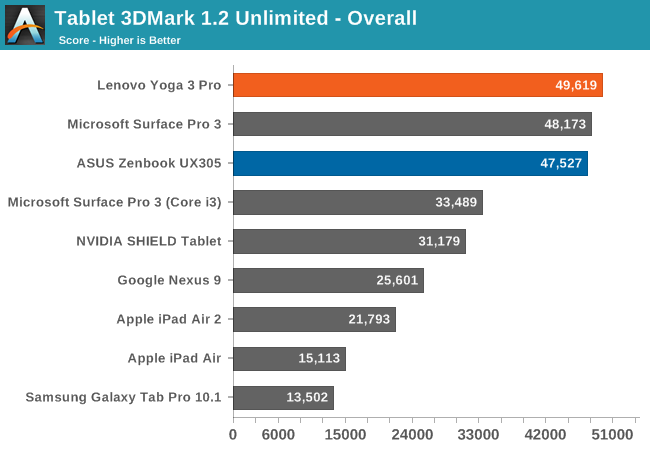
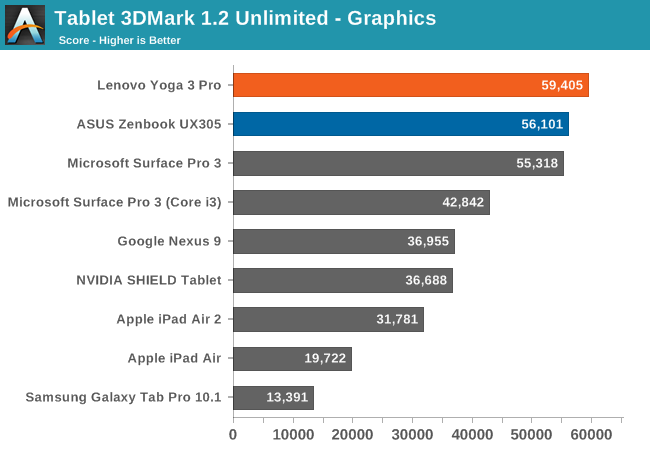

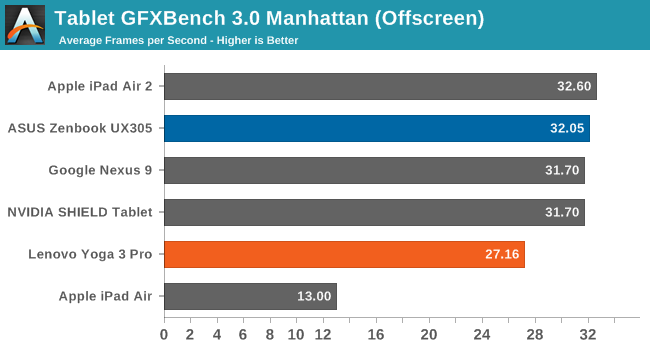
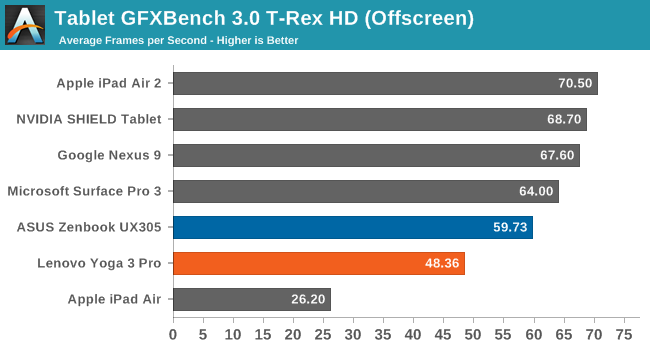


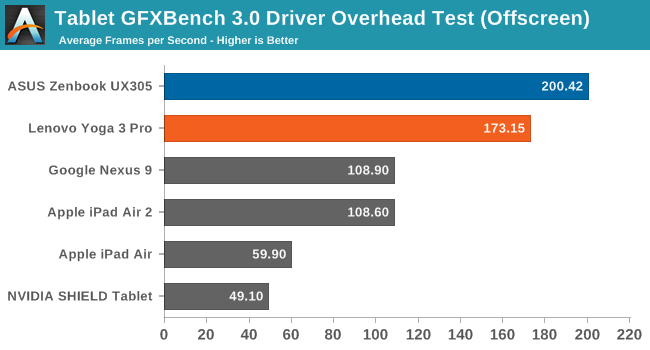
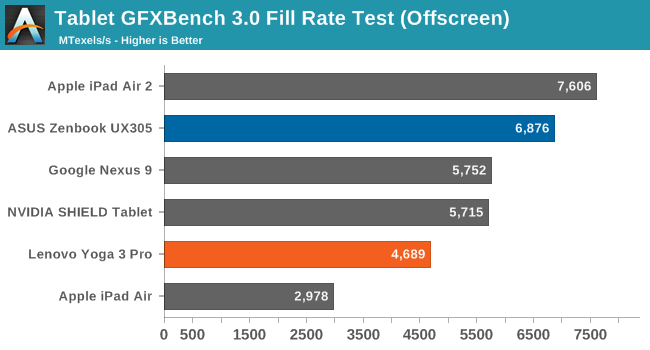
3DMark Unlimited shows the capabilities of the GPU, but is so short that the throttling issues we have observed do not come in to play. The Gen8 graphics of HD 5300 should certainly be able to compete favorably to any of the tablet SoCs if give enough headroom, however that is obviously not the case.
The GFXBench scores show that the Core M 5Y10 can compete with tablets, with it coming in very close to the same scores as all of the latest tablets on the Manhattan score. The T-Rex benchmark is much easier, and it falls behind a bit, but is still a lot quicker than the Yoga 3 Pro.
GPU Conclusion
The increased thermal headroom that ASUS allows on the UX305 has dramatically increased the GPU performance of Core M when compared to the Yoga 3 Pro. The device does get warm though, with it hitting close to 50°C at the top of the laptop, but it does not affect the keyboard or wrist areas. The lack of a fan makes these scores even more surprising, but Lenovo has opted to keep the surface temperatures a lot lower on the Yoga 3 Pro.
There is a lot to be said about Core M performance, and too much to put in this review. We will be doing a deeper dive into the performance of Core M and how it performs in various devices, both actively and passively cooled, as well as compared to Broadwell-U based systems which are a more traditional design. Clearly, there is a lot of factors that affect performance in a device such as this than just the label on the spec sheet.


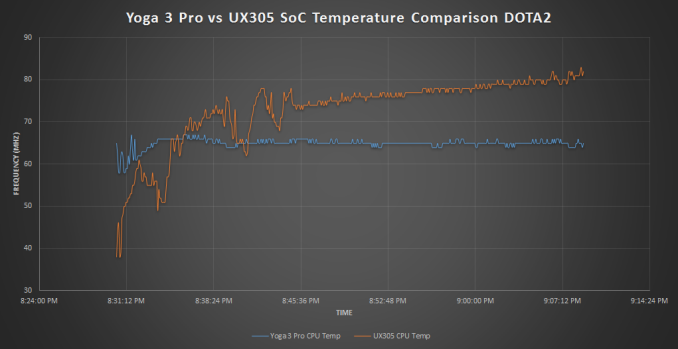








164 Comments
View All Comments
tipoo - Wednesday, March 25, 2015 - link
I was curious where Core M stood against some mid range 4-5 year old systems, namely Core 2 Duo. I checked on the Notebookcheck mobile CPU and GPU benchmarks, and it doesn't seem appreciably faster than the P8600/320M combo in an old white unibody macbook we have, for instance. The CPU scores a bit higher, not earth shattering, the GPU looks to track around the same. Is that wrong?tipoo - Wednesday, March 25, 2015 - link
Not to say that that's not impressive, going from that in 35+23 watts to a total of 5 watts, but it's not a huge upgrade for people on those systems either, apart from form factor and screen etc.Krysto - Wednesday, March 25, 2015 - link
That's great and all, except....who asked for a 5W notebook chip? Intel has been doing this for a while, moving the MAINSTREAM of the notebook market from M/H-series chips to U (CULV) series chips...and now to the even less powerful Y-series, which until Broadwell was so crap nobody dared to put it in their laptops (IVB-Y and Haswell-Y). Core M is just a slight upgrade over those.It's already happening. We're already seeing "ultrabooks" such as this Asus, and the new Macbook Air arriving with these crappy chips, and making us pay $1300 for the privilege. Why the hell wouldn't I just use an ARM chip at this point in a $500 Chromebook, and with the same quality screen and materials?
damianrobertjones - Wednesday, March 25, 2015 - link
I was with you until you mentioned 'chromebook'. That threw everything out of the window and, honestly, you'd be a bit silly to even consider such a machine.Mikemk - Wednesday, March 25, 2015 - link
You'd be silly to consider it for Chrome OS yes, but they can be good hardware with Linux Mint installed.tuxRoller - Friday, March 27, 2015 - link
Not mint, and not with that tiny amount of storage, and not at that price.If they had at least made the storage upgradable it would've been the PERFECT linux lappy.
akdj - Thursday, March 26, 2015 - link
True. Chromebooks seem silly, and an answer to nothing right now, in today's state of technology. I think Krysto, you're missing a few things...just as comparing this to a 2010 Air or an '08 MacBook. It's got 8GB of RAM. The earlier MacBooks were 2, an option of four but no more. They were either using 5400 RPM HDDs or the earliest, slowest SSD technology, they didn't aport IPS panels (nor options like HiDPI <&1000!!). You were lucky to get two, two and a half hours on the old, white plastic MacBooks, maybe an hour more on the '10 Air....they were thicker, heavier, and not anywhere close to today's GPU solutions integrated, sharing some of that RAM, in some cases 2GB of its internal/existing system memory when necessary. Along with the improvements made to OS X, this is a machine built for 'Most'......Not you and I. Different needs, all that but plenty are getting by everyday without turning a laptop or their desktops at home on. iPads, your Nexus or Samsung tablet of choice -- even today's smartphones smoke those older MacBooks for all reasons mentioned above; portability, longevity, 'speed' (with PCIe storage now, quick NAND solutions in tabs), and overall function.
There's a WHOLE lot of folks using their iPad for their email, facebook, casual gaming and web surfing, entertainment and media, constant, 'everywhere' connectivity radios and phenomenal displays you can throw in a bag and forget it's there. Even charge it with a cigarette lighter. Same applies to today's phablet phones ...as we've seen tab sales drop whether it's due to over saturation of the tablets in those who already 'want them', a slower upgrade cycle and/or the 'phablet' craze with incredible, HiDPI 5-6" display phones in our pockets...with the SAME power as their tablet counterparts (some compared favorably in this review ...IOW, iPhone 66/6+, Note 4 and incoming S6, new LGs, HTCs and iPhones, these 'phones' are going to be competing even more favorably this year to these ultra book scores, that's cool!)
Point being 'Most' folks haven't the needs or just plain 'wants' those of us frequenting Anandtech are looking at for our next computer. That said, a dozen hours, two pounds and those improvements are all fine choices for someone not rendering video or manipulating 200 RAW 50mpxl images 'on the run' --- the perceived and 'real speed' increases via SSD storage, the iGPU and fabless quiet design might just make for an excellent commuter computer for many of us, at just 7-$999! Like the new MacBook, it's got a place in the marketplace for the masses but if it's not the solution you're lookong for the Broadwell 35/45 watt MacBook pro, XPS 15 and 17" workstations, etc ...they'll be here sooner than later and from all things I've seen, other than maybe a 5-8% power increase and savings over Haswell, there's plenty of options on the market today that cover the bases
I'll be 44 this year and started with an Apple IIe. What a cool time to be a 'geek'!
J
eanazag - Monday, March 30, 2015 - link
If Chromebooks could do RDP, than they would make decent thin clients. Otherwise, I don't find much value in them except for cases where you want your device to only be a browser from a management standpoint.Marc GP - Thursday, April 9, 2015 - link
They can.https://chrome.google.com/webstore/detail/chrome-r...
8steve8 - Thursday, April 23, 2015 - link
that's not RDP, that's chrome remote desktop. not a terrible solution, but in my limited experience had issues vs RDP.